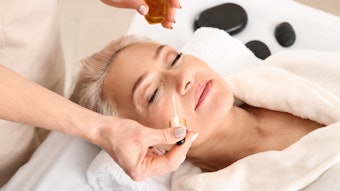
Scalp facials are taking center stage in the wellness world, and spas are beginning to see the real potential of this trending treatment—not just for hair and scalp health, but also as a highly profitable addition to their service menus.
Driven by increasing consumer awareness of holistic beauty and amplified by social media, scalp-focused treatments are evolving far beyond a shampoo and rinse. These services now combine luxury, customization and results that keep clients coming back. As two leaders in this space confirm, they’re turning into serious revenue generators.
A Category All Its Own
At The Scalp Lounge in Lehi, Utah, scalp care is not a menu add-on—it is the menu. The business, founded by licensed cosmetologist and educator Mandie Sue Evans, offers highly customized, full-spectrum scalp treatments rooted in trichology and wellness.
“Scalp facials are a necessity, just like dentist appointments or getting your nails done,” Evans shares. “They’re not fluff—they’re serious solutions for scalp and hair health, delivered in a luxurious way.”
A typical treatment at The Scalp Lounge includes scalp scoping and imaging, a pH test, dead cell removal, growth serums, exfoliating scrubs and high-frequency stimulation. Most clients opt for the signature 60-minute Scalp Care Treatment ($160) or upgrade to luxury packages that can reach up to $350. Hair loss plans and personalized regimens extend into the thousands.
“We’ve seen more profitability from this service than any other across the board,” Evans notes. “It’s life-changing, both for clients and for spa professionals offering it.”
At Canyon Ranch Spa + Fitness in Las Vegas, scalp facials have also found their place alongside the spa’s full menu of traditional offerings. Their 90-minute Hair and Scalp Treatment is designed to condition, soothe and restore balance—addressing concerns like dryness, itchiness and product buildup.
“The demand became clear as soon as we launched the service on our website—bookings tripled,” says Geneva Hancock, Salon Assistant Manager. “It’s now one of our most requested specialty treatments.”
Why Clients Are Booking
From excessive oiliness and dryness to thinning hair and buildup from products or hard water, scalp issues are far more common than many people realize. Until recently, there simply weren’t mainstream services to address them.
“The scalp is skin—and it's often overlooked,” says Evans. “We’ve created a space that prioritizes scalp care with the same level of attention as a facial or massage.”
Social media has played a significant role in normalizing scalp health conversations. Viral videos of steamy rinses, gentle exfoliation and post-treatment shine have made scalp facials aspirational. At Canyon Ranch, this digital exposure helped fuel interest. “Instagram and online booking access helped us get the word out,” says Tessa Montoya, Lead Hairstylist.
But once clients try the treatment, it’s the results that hook them. Improved scalp health leads to better hair growth, longer-lasting color, and reduced irritation—making the treatment an easy upsell for stylists and aestheticians.
Building a Business Around Scalp Care
For spas and salons looking to capitalize on the scalp facial trend, customization and proper training are key. At The Scalp Lounge, every treatment starts with an in-depth analysis using 200x magnification, allowing providers to tailor each session to the individual. From there, a structured menu and pricing model lets clients add on services based on their needs—like facial elements, paraffin hand wax or targeted product regimens.
“Every scalp tells a story,” says Evans. “And it’s our job to help rewrite it.”
Evans also recommends investing in clean, high-performance products. Her team uses a plant-based, low-tox system with reverse osmosis water to support hair and scalp health without irritating sensitive skin. Canyon Ranch relies on Kerastase products for consistent, high-quality results.
Both businesses emphasize that staffing is crucial. “Scalp facials should be performed by licensed professionals who understand the skin and hair systems,” says Evans, who also runs Academy M Education, a training platform for spa and salon professionals. “Education is the backbone of doing this right.”
At Canyon Ranch, stylists undergo in-depth product training and are tested for proficiency before performing the service. “Consistency and product knowledge are essential,” Hancock adds.
The Profit Potential
Scalp facials can bring in serious revenue, particularly because they blend self-care with problem-solving. At The Scalp Lounge, services range from $175 to $350, with add-ons and retail products offering additional profit margins. Their customized hair loss treatment plans—which can include product regimens and follow-ups—extend that profitability even further.
Canyon Ranch structures their service pricing to reflect peak demand, charging $189 Monday through Thursday and $199 on weekends. The treatment’s high perceived value makes it an attractive booking, especially for wellness travelers looking for something different.
Both spas agree that retail is an important component of the model. “Clients want to maintain their results at home,” says Montoya. “So we educate them on product use and the importance of scalp care between visits. That drives retail sales and increases long-term client satisfaction.”
Advice for Spas Considering the Trend
For spa owners or directors looking to enter the scalp facial space, the message is clear: get trained, get intentional and market smart.
“Scalp care isn’t a trend to us—it’s a movement,” says Evans. “But if you want to get into it, do it right. Take the courses, understand the science and lead with authenticity.”
Social media remains a powerful tool, but education—both internal and external—is what sustains momentum. “Your staff should understand why scalp health matters, so they can confidently share that with clients,” says Hancock.
In a competitive spa landscape, scalp facials offer a unique edge: high-touch, high-value services that deliver real results. Whether built into a full-scale wellness menu or launched as a standalone specialty, these treatments are proving to be not just trend-worthy—but bankable.








